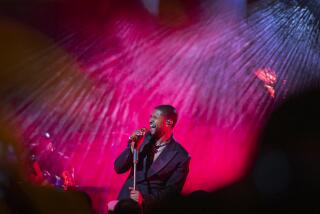BeyoncĂ©âs âHomecomingâ Coachella pyramid merges art and flash
Talk of the great pyramid may have been forever changed in April 2018. Thatâs when BeyoncĂ© and 151 dancers and musicians took the Coachella stage for two weekends for âHomecoming,â a performance that later became the basis of the singerâs Emmy-nominated Netflix documentary of the same name.
In October 2017, BeyoncĂ© tapped Stufish, a London-based team of âentertainment architects,â to design and erect the 24-foot pyramid that would span the stage. The team at Stufish took their cues from the singerâs vision, which was to evoke the aesthetic and energy of American historic black colleges, yet still look like a work of art.
âShe had an idea of what she thought âHomecomingâ was and she definitely knew she wanted a lot of people and that there would be some kind of pyramid structure,â says Ric Lipson, a partner at Stufish and the lead designer on âHomecoming,â who is also Emmy nominated for production design for a variety special.
âBut we went through quite a lot â at least 20, maybe 30 â pyramid-like structures, from something that looked like a Mayan temple to something that was a bleacher in a pyramid shape. Once we hit upon the bleacher shape, which was what she focused on, it felt like something understood from the sports field of the historic black colleges as an aesthetic, but it had to be turned into an art piece.â
While the final pyramid may look simple, getting the details right was a challenge. Lipson, speaking from New York where he is finalizing Madonnaâs âMadame Xâ tour, had to consider several factors when determining the height of the bleacher steps. If they built the steps 14 inches high it would be easier for the dancers and musicians to climb up and down, but vertical height of the entire structure would be lost. If they built the steps at 18 inches, the pyramid would look taller, but it would be harder to scale.
Lipson built a mock-up of each step height and presented both to BeyoncĂ©. She chose the 18-inch version. âWe always give a practical solution along with an artistic one,â Lipson notes. âItâs a combination of designing something we know looks great while also knowing it works.â
The team also made adjustments to the actual Coachella stage, including reinforcing the structure, adding small lifts into the stage and using space in the VIP area to build an elevating b-stage for the singerâs performance of âDrunk in Love.â âIt was literally pushing the boundaries of what the festival would allow,â Lipson says. âThe festival was very supportive and understood how the performance needed to go. Weâre very lucky they allowed us to do all that.â
A major consideration was how the set would be moved onto the stage before her headlining performance. The team had 45 minutes to move it out, secure all the elements and get the dancers and musicians in place. This required a crew of about 40 people who rehearsed how to place the set pieces several times on a soundstage before it ever arrived to Coachella.
âIt was pretty amazing to watch,â Lipson says. âIt was the choreography before the choreography, as we like to say. Itâs not just from the minute the performer is on the stage â the crew has their own performance before the show.â
In total, Stufish built three versions of the set: the final design, a mock-up design for rehearsals and an 8-foot-by-8-foot rendition to test out on BeyoncĂ© and the dancers. That smaller version allowed the team to check what sort of grip would be needed for the steps, taking note of the windy desert environment. The final set was completed in mid-March, allowing the performers nearly a month to rehearse in a Los Angeles soundstage. Cameras were part of the rehearsal process, and Lipsonâs team helped to ensure that every eye-line looked right.
âWhile we didnât know it was being filmed for Netflix weâre always aware that something is being filmed and those shots are taken into account,â Lipson says. âWe spend weeks in rehearsal watching specifically as the camera mix gets finalized to make sure thereâs not something in a shot that doesnât look right or is ugly. We really had to think about the image of the show and the way the cameras were working as one cohesive piece. Every shot was choreographed so she knew where she was looking, and we knew it was captured correctly.â
Lipson, who designed BeyoncĂ© and Jay-Zâs âOn The Run IIâ tour directly after Coachella wrapped, sees his Emmy nomination â one of six for âHomecomingâ overall â as a great step for Stufish. âWeâre 19 people designing various things, from shows to buildings, and weâve won some architectural awards in the past in the trade industry,â he says. âBut weâve never really won â or been nominated for even â a prestigious thing like the Emmys. We all knew this was going to be something special, but I donât think anyone realized how special.â
He adds, âIt was a great challenge because whenever something is quite hard to do it becomes much more rewarding when youâve done it. And the pyramid was great, but without the choreography on it, it would just be a load of metal. The set is one part of a massive effort by hundreds of people.â
More to Read
From the Oscars to the Emmys.
Get the Envelope newsletter for exclusive awards season coverage, behind-the-scenes stories from the Envelope podcast and columnist Glenn Whippâs must-read analysis.
You may occasionally receive promotional content from the Los Angeles Times.










